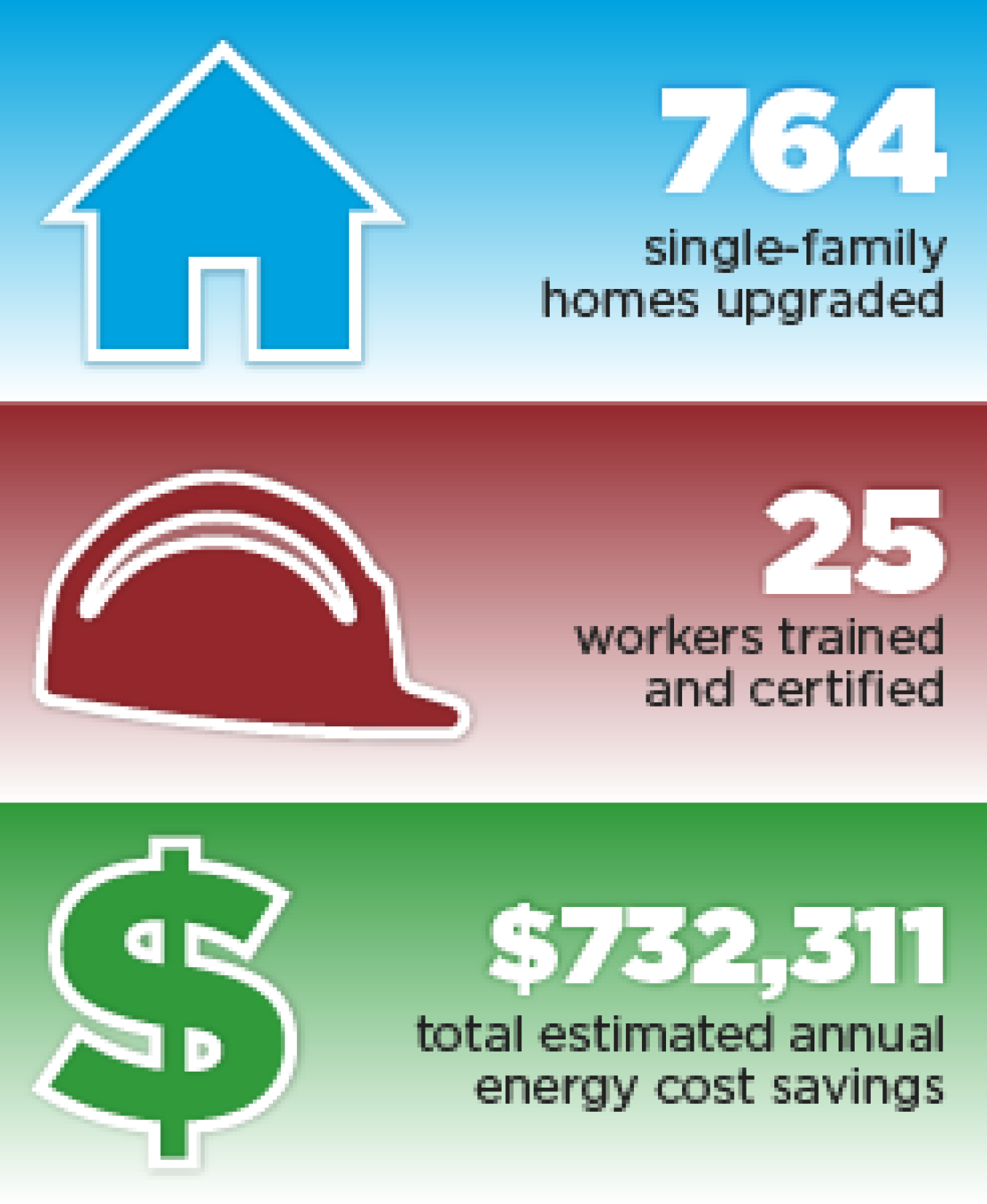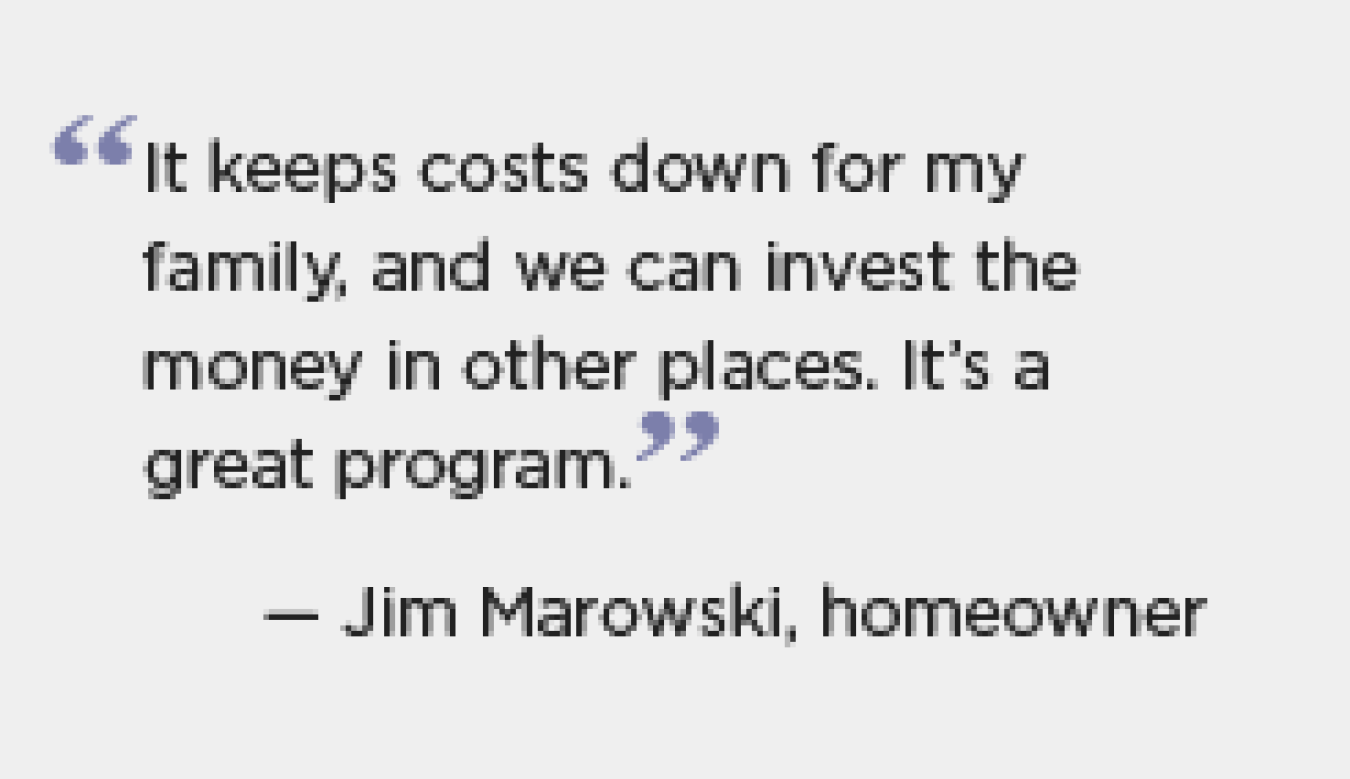
Massachusetts’ longstanding statewide Mass Save energy efficiency program, supported by ratepayer funds and sponsored by utilities, has resulted in the state being named first in energy efficiency by the American Council for an Energy Efficient Economy for the past four years. Even with this accolade, the state wanted to test strategies to achieve more—and deeper—home energy upgrades.
Using $2.6 million in seed funding from the U.S. Department of Energy’s Better Buildings Neighborhood Program, the Massachusetts Department of Energy Resources (DOER) launched an innovative initiative to pursue this goal. The initiative, called the Home MPG (Miles per Gallon) Program, built off the Mass Save residential program and focused on the Springfield metropolitan area. The Home MPG Program featured a home energy performance scorecard; enhanced financial incentives and technical assistance to implement efficiency upgrades; and education of the residential real estate community on valuing home energy performance.
Defining Characteristics
Approaches Taken
Key Takeaways
What’s Next?
Additional Resources
Defining Characteristics
DOER partnered with electric and gas utilities; organizations that implement Mass Save for the utilities; home energy professionals and contractors; Massachusetts real estate industry educators; and local community organizations to launch the Home MPG program. Home MPG covered Springfield and seven nearby municipalities: Belchertown, East Longmeadow, Hampden, Longmeadow, Monson, Palmer, and Wilbraham.
Home MPG provided a home energy performance scorecard to residents in conjunction with a Mass Save no-cost home energy assessment and again after efficiency improvements were completed. The scorecard offers home-to-home comparisons similar to the way a car’s miles-per-gallon rating allows for easier comparisons among car models. It presents two metrics: the home’s energy performance score (EPS), expressed as the expected total energy usage in one year, and the home’s carbon footprint. The scorecard also shows potential changes to those metrics if recommended cost-effective efficiency upgrades were made, and the EPS and carbon footprint of an average home in the area as a motivational point of reference.
In an effort to institutionalize the EPS in the residential real estate market, Home MPG provided training for residential real estate brokers and appraisers on home energy performance and how it can be integrated into the sales and appraisal processes. Home MPG also provided Mass Save customers with additional financial incentives and rebates for insulation and high efficiency heating, ventilation, and air conditioning (HVAC) and hot water system equipment, in addition to those already available under the longstanding Mass Save program. Read more in the Mass Save final report.
Accomplishments
(July 2010 to March 2014)


Approaches Taken
From giving homes an EPS to providing bonus incentives, DOER leveraged the Home MPG program to test innovative strategies.
- Residential Program Design: Home MPG’s used the scorecard as a benchmarking tool for residential energy efficiency. To further spur residents to improve the comfort and energy performance of their homes, the Home MPG program also provided secure online access to infrared thermal imaging and analysis, which showed homeowners exactly where their homes were losing heat.
- Marketing and Outreach: The Mass Save program conducts regular outreach through radio, billboards, print, and Web-based media. Local organizations Pioneer Valley Planning Commission and the Center for Eco-Technology were brought on to conduct marketing specific to the Home MPG initiative. The initiative was promoted at local events and stores; advertised on various news and radio stations; and publicized in local news outlets. More than 20,000 utility customers received mailers detailing Home MPG offerings.
- Financing: The Mass Save program offers various financial incentives for home energy upgrades, as well as a loan product with 0% interest called the Mass Save HEAT Loan. To facilitate deeper energy and economic savings, Home MPG provided customers with additional financial incentives and rebates for insulation, high efficiency HVAC, and hot water system equipment. The Home MPG rebates (i.e., $2,000 for qualifying cold climate ductless mini-split heat pumps; $1,000 for qualifying heat pump water heaters; and 75% up to $16,000 for qualifying wood pellet boilers/furnaces) covered specific technologies that typically save money for customers with existing oil- or propane-based heating systems. Later in the program, Home MPG added a technical assistance service option to help customers interested in HVAC and hot water system upgrades. In addition to actively promoting all available incentives and rebates, including the standard Mass Save ones, Home MPG recruited three local banks to become Mass Save HEAT Loan providers in what was previously an underserved region of the state.
- Workforce Development: The Home MPG program leveraged the list of home energy professionals and contractors qualified under the Mass Save program, which requires Building Performance Institute certification. The Home MPG initiative provided training for these professionals on the interaction between Mass Save and Home MPG; energy professionals also received training on the EPS software. In addition, an energy education nonprofit, Earth Advantage Institute, and a broker education school, The Leading Edge Academy, offered training for residential real estate brokers and appraisers to help these professionals understand home performance and how it can be integrated into the sales and appraisal processes. In total, more than 150 real estate professionals attended the trainings, and brokers received continuing education credits for the broker training course.
Key Takeaways
Building on Mass Save, Home MPG demonstrated strategies designed to facilitate greater investment in residential energy performance. Lessons learned include the following:
- Build off existing programs and partnerships. Home MPG was integrated into the established Mass Save program, which allowed the initiative to focus on innovations like EPS and bonus financial incentives for specific types of upgrades while relying on Mass Save for qualified contractors, basic financial incentives, and statewide marketing.
- Innovate to engage. Home MPG piloted a new home energy performance rating system, experimented with financial incentives, and embraced the use of technology. The EPS and infrared thermal imaging tools allowed participating energy professionals to educate and interact with homeowners in new ways.
- Institutionalize energy efficiency through the real estate market. In addition to training home energy professionals and contractors, the Home MPG program educated real estate brokers and appraisers on residential energy efficiency and EPS.
- Focus on local context. The Home MPG rebates for high efficiency renewable HVAC and hot water technologies were tailored to benefit the significant portion of local homeowners who use oil or propane for heating.
What's Next?
Although the Home MPG initiative was only active for two years, it made a lasting impression in the Massachusetts energy efficiency landscape. Sustainable aspects of the program include:
- As a result of the Home MPG initiative, two organizations that implement Mass Save have integrated scorecard capability into their energy assessment software.
- Other communities are interested in the EPS becoming a standard part of Mass Save home energy assessments; the City of Worcester, for example is implementing its own pilot program using the EPS.
- Massachusetts partnered with Alabama, Washington, and Virginia to form a knowledge-sharing collaborative of states with home energy efficiency pilots. Massachusetts has promoted the use of EPS through this multi-state collaborative and through other partnerships at the national level.
Additional Resources
Reports
Stories & Videos
